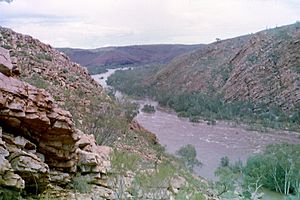Wunaamin Miliwundi Ranges facts for kids
The Wunaamin Miliwundi Ranges are a long chain of hills in the western Kimberley region of Western Australia. For many years, from 1879 to 2020, they were known as the King Leopold Ranges.
Inside these ranges, there are two special areas called conservation parks. These are the Wunaamin Conservation Park and Miluwindi Conservation Park. The Wunaamin park is on Wilinggin land, and the Miluwindi park is on Bunuba land. Both of these parks used to be part of a bigger park called the King Leopold Ranges Conservation Park.
Contents
Why the Name Changed
The ranges were first named on June 6, 1879, by an explorer named Alexander Forrest. He was exploring the Kimberley area and named them after King Leopold II of Belgium. Forrest said he chose the name because the King was very interested in exploration.
Over time, people wanted to change the name of the ranges. This was because King Leopold II's rule over the Congo Free State (starting in 1885) was linked to the deaths of many African people. Leopold had no connection to Western Australia. However, many places in the Pilbara and Kimberley regions were named after European royalty.
People first suggested changing the name in 2008 and again in 2017. It took a while to change because the ranges are very large. They cross different areas and lands belonging to various traditional owners. So, discussions with these groups were needed to pick a new name.
In 2020, a statue of Leopold II was removed in the city of Antwerp. This was part of a worldwide look at names that might cause upset. After this, Lands Minister Ben Wyatt said he hoped to agree on a new name with the two main native title groups. He wanted to change the name quickly after that.
The ranges were officially renamed on July 1, 2020, by Lands Minister Ben Wyatt.
What the Ranges Look Like
The Wunaamin Miliwundi Ranges are a special part of the larger Kimberley Block. This whole area is part of the even bigger West Australian Shield. The Wunaamin Miliwundi Range is actually made up of many smaller ranges. These include the Lady Forrest Range, Isdell Range, Narrie Range, Sir John Range, Precipice Range, and the Durack Range.
Close by, you can find places like Mount Hart, Bell Gorge, Silent Grove, and Lennard Gorge. There are also the Napier Range and a large granite rock called Queen Victoria's Head. The Fitzroy River cuts through the area, forming Fitzroy Bluff.
These ranges separate the main Kimberley plateau from the flat plains of the southern Fitzroy area. The ranges are mostly made of quartz sandstone with some dolerite rock mixed in. They are shaped like a crescent moon. They stretch for about 567 kilometres (352 miles). This runs from the northern end of the Durack Range in the east to east of Secure Bay in the West Kimberley.
The ranges cover a huge area of about 30,794 square kilometres (11,890 square miles). The average height of the area is around 600 metres (1,969 feet). The very highest point is Mount Wells, which is 983 metres (3,225 feet) above mean sea level. The next two highest peaks are Mount Ord at 936 metres (3,071 feet) and Mount Broome at 927 metres (3,041 feet).
A Look at History
The traditional owners of this land are the Ngarinjin, Konejandi, and Bunuba peoples. They have lived here for a very long time.
Cattle were first moved across the ranges in 1903. They started from Fitzroy Crossing and were taken to stock Mount Barnett Station. This journey took more than six weeks to finish.
How the Ranges are Cared For
The Gibb River Road crosses the ranges about 134 km (83 mi) east of Derby. A large part of the ranges is protected within the Miluwindi Conservation Park and the Wunaamin Conservation Park. These parks cover about 3,921 square kilometres (1,514 square miles). They are looked after by the Department of Parks and Wildlife.
If you want to visit, camping is allowed at Mount Hart Station, Bell Creek, or Silent Grove.


